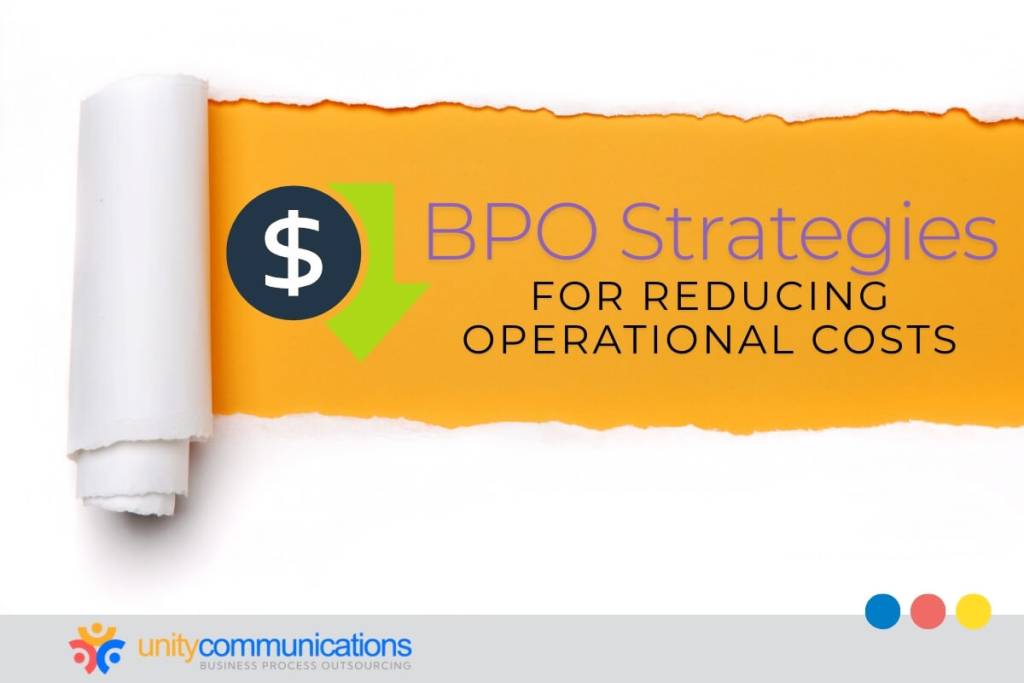Table of Contents
Cost cutting is not just a strategy for boosting profit margins—it is vital for survival. Effective cost management keeps a company financially stable and competitive in the market and builds resilience in an unpredictable economy.
To help your organization hit those targets and make every dollar count, business process outsourcing (BPO) offers readily available solutions to reduce operational expenses without sacrificing service quality or performance.
Read on to discover top-tier BPO strategies for reducing operational costs.
The importance of reducing operating costs

The transactional nature of business operations makes profitability a critical focus for any company’s survival. Reducing operational costs is often the first step toward boosting profits because it directly affects the bottom line.
However, savings must not come at the expense of product quality or customer satisfaction, as it is not sustainable. For example, research shows that 32% of customers would stop doing business with their favored brand after one bad experience. Companies must find ways to cut costs without compromising service quality.
One way to strategically leverage cost-cutting is to reinvest savings in growth areas such as research and development (R&D) or marketing.
Consider a software-as-a-service (SaaS) company that successfully reduces operating costs by transitioning to a scalable, cloud-based solution. It reinvests a part of its savings into R&D, integrating AI to enhance its product’s value, improve user experience, and meet customer demands. The remaining savings funds targeted digital marketing campaigns to expand the company’s reach in high-growth industries, drive customer acquisition, and increase revenue.
Additionally, improved cash flow through reduced expenses enables businesses to weather economic downturns or invest in technologies that enhance operational efficiency.
By implementing strategic cost-reduction initiatives, companies can improve profit margins while enhancing resilience and maintaining competitiveness. In short, cost reduction tightens the purse strings while ensuring long-term sustainability and profitability.
BPO strategies for reducing operational costs

What is BPO, and how does it help businesses reduce costs? BPO is contracting specific business tasks or processes to a third-party service provider. It allows companies to leverage external expertise and resources and significantly reduce their in-house labor, infrastructure, and technology expenses.
BPO is a popular strategic tool for enhancing cost efficiency. About 88% of businesses surveyed in 2023 reported cost reduction via outsourcing.
Below is how BPO companies reduce operating costs:
Implementing performance-based contracts
Performance-based contracts help businesses get the most value from their BPO partnerships. These contracts align the provider’s performance with the company’s goals, ensuring that both parties work toward the same objectives.
These contracts typically include specific performance metrics, such as turnaround time, accuracy, and customer satisfaction. Tying payment to these metrics encourages a BPO provider to deliver high-quality services. This approach also reduces the risk of inefficiencies and incentivizes the firm to optimize its processes.
Performance-based contracts also provide flexibility. If the BPO provider fails to meet the agreed-upon targets, the business can negotiate for reduced fees or additional services. This helps control costs and drives continuous improvement in the outsourced processes, resulting in better performance.
Utilizing scalable solutions to adjust costs with demand
One primary advantage of BPO is scalability. Businesses often experience fluctuating demands, and maintaining a full-time workforce to handle these variations can be costly. BPO providers offer flexible staffing models that allow companies to scale their operations based on need.
Scalability is particularly valuable for seasonal businesses or companies experiencing rapid growth. During peak periods, companies can quickly ramp up their BPO teams to manage increased workloads without the expense of hiring and training additional staff. In slower seasons, they can scale down to avoid unnecessary costs.
This flexibility extends beyond staffing, with many BPO providers leveraging advanced technologies to adapt swiftly to clients’ changing business needs.
Technologies for Scalability
BPO providers often use cloud-based platforms to enable remote access, real-time data sharing, and scaling processes without adding physical infrastructure. For example, during holiday shopping surges, a BPO can quickly onboard additional agents with secure access to a cloud-hosted CRM system.
Robotic process automation (RPA) is another vital BPO technology for managing high-volume, repetitive tasks during peak demand. Bots automate invoice processing and data entry to let human agents focus on more complex tasks without increasing labor costs.
BPO providers leverage artificial intelligence (AI) and machine learning (ML) to further boost scalability. AI chatbots answer routine inquiries 24/7, managing demand spikes without extra staffing. ML algorithms quickly process and analyze large datasets for more crucial, real-time decisions.
Omnichannel communication platforms allow BPO teams to manage customer interactions seamlessly across email, chat, social media, and phone channels. This mainly benefits companies launching new products or marketing campaigns, as the BPO provider can manage increased customer inquiries across various channels.
Utilizing these scalable BPO solutions enables businesses to control costs while remaining agile and responsive to market demands. Technology-driven flexibility also helps companies meet their evolving needs without the high costs of hiring in-house staff or investing in additional infrastructure, reducing operating expenses.
Leveraging offshore outsourcing for cost advantages
Offshore outsourcing is among the proven BPO strategies for reducing operational costs. Companies can save significantly on wages and benefits by outsourcing tasks to countries with lower labor costs. This is particularly advantageous for those looking to scale operations without incurring high domestic labor costs.
In addition to cost savings, offshore outsourcing offers access to a global talent pool. BPO providers in India and the Philippines specialize in customer support, information technology (IT) services, and back-office operations. These vendors bring expertise and quality to the table, so businesses receive top-notch service at a fraction of the cost.
Although concerns about communication and time zone differences exist, modern BPO providers use advanced tools to bridge these gaps. With effective management strategies and robust communication channels, businesses can leverage offshore outsourcing to maintain operational efficiency without sacrificing quality.
Streamlining operations through process automation
Process automation is one of the most effective strategies for reducing costs. According to a 2022 Deloitte report, companies implementing intelligent automation can reduce operating costs by up to 31%. BPO providers use advanced technologies such as RPA and AI to automate repetitive tasks.
Automation also leads to faster processing times, boosting productivity. For example, platforms can complete data entry and invoice processing in a fraction of the time compared to manual handling. This speed lowers costs and improves service delivery.
Additionally, process automation promotes better compliance management. It reduces the risk of human error, further saving compliance fines and rework costs.
Companies can streamline their operations effectively by partnering with a BPO provider specializing in process automation. These providers offer customized automation solutions that reduce costs and optimize workflows for efficiency and scalability.
Getting access to cutting-edge technology without significant investment
Integrating advanced technologies such as AI, machine learning, and cloud computing into business processes can significantly enhance efficiency. BPO providers are at the forefront of technological innovation, offering clients access to state-of-the-art tools without the hefty price.
AI and machine learning, for example, can transform routine operations by automating previously time-consuming and error-prone tasks. With AI-driven tools, data entry, customer support, and analysis become more accurate and efficient.
Machine learning allows companies to derive actionable insights from vast amounts of data. With the technology, BPO providers can analyze customer behavior, market trends, and operational inefficiencies, which informs business decisions.
Additionally, cloud-based solutions offered by BPO providers enable seamless collaboration and data sharing. They reduce the need for physical infrastructure and enhance remote working capabilities. The integration keeps businesses agile, cost-effective, and updated with technological advancements.
Optimizing workforce management and allocation
Effective workforce management directly influences operating costs by maximizing employees. BPO providers excel in this area, bringing expertise in recruitment, training, and performance management to optimize workforce allocation.
Additionally, BPO companies can adjust staffing levels based on fluctuating needs, allowing businesses to scale their workforce without the financial strain of hiring or laying off full-time employees. This flexibility also decreases overtime, training, and turnover spending and maintains a lean operation.
As a result, optimized workforce management enhances productivity and significantly reduces the expenses tied to workforce inefficiencies.
Reducing overhead costs with virtual teams
A Global Workplace Analytics report in 2022 indicated that businesses can save an average of $11,000 per employee annually by implementing remote work.
Virtual teams can reduce office space, utilities, and on-site equipment expenses. BPO providers also equip remote workers with the tools to collaborate effectively. Examples include cloud-based project management systems and communication platforms.
In addition, virtual teams provide businesses with access to a global talent pool. For instance, GitLab operates with team members in over 65 countries, enabling it to source top-tier talent in software development and customer support without the costs of maintaining physical offices.
Similarly, Automattic, the parent company of WordPress, relies on a fully remote workforce spread across 70 countries. This setup allows the company to provide 24/7 customer support while avoiding regional salary premiums.
Toptal also connects companies with remote professionals in specialized fields such as software development and finance. Its clients can hire on a project basis instead of paying full-time salaries or benefits.
By leveraging virtual teams, businesses can access specialized skills, maintain cost efficiency, perform superbly, and broaden global reach.
Improving vendor management and negotiation
Effective vendor management is one practical but often overlooked BPO strategy for reducing operational costs. The relationship between a business and its BPO vendor hinges on strategic collaboration. Because of this, companies can negotiate better terms and conditions and receive the best value for their investment.
A well-negotiated BPO contract considers the business’s unique requirements of the company. Examples include the scope of services, performance expectations, and desired outcomes. BPO providers often offer various customizable services and flexible pricing models depending on the client’s needs.
For example, a company might negotiate a contract with performance-based pricing, where metrics such as improved customer satisfaction or faster processing times dictate service costs. The client only pays for the services it needs and values, leading to more efficient resource use.
Additionally, effective vendor management involves continuous performance evaluation. Regularly reviewing the BPO provider’s performance helps identify areas for improvement and cost-saving opportunities. This proactive approach ensures the partnership remains cost-effective and aligned with the company’s evolving needs.
Adopting flexible pricing models
Flexible BPO pricing models can help businesses optimize costs based on their unique needs. Instead of a one-size-fits-all approach, BPO providers offer various pricing options, such as pay-per-use, subscription-based, and outcome-based pricing.
This adaptability is particularly beneficial for businesses that face fluctuating workloads or need to adjust their operations based on market dynamics. By offering various pricing options, such as pay-per-use, subscription-based, and outcome-based pricing, BPO providers enable companies to find the most cost-effective solution for their needs.
Pay-per-use models allow businesses to pay only for their services, making it ideal for companies with fluctuating demands. Subscription-based pricing provides a predictable monthly cost, which can help with budgeting and cost control. Outcome-based pricing ties the payment to specific results, so businesses only pay for successful outcomes.
By adopting flexible pricing models, companies can better manage operating costs and avoid the pitfalls of rigid, traditional pricing structures. This approach is one of the vital BPO strategies for reducing operational costs and aligning expenses with operational needs.
The bottom line

You know your business better than anyone. Although operating costs differ for every company, the strategies are customizable based on business size and needs. You might get caught up in managing expenses, but by adopting suitable measures, you can take control and reduce these costs effectively.
By leveraging process automation, performance-based contracts, scalable solutions, and other BPO tactics, you can streamline your operations, access global talent, and remain flexible in an ever-changing market. These methods help your businesses save on labor, infrastructure, and overhead while maintaining high service standards.
The actual cost of outsourcing is an investment in your business’s long-term efficiency and sustainability. BPO offers a path to smarter cost management to enhance your company’s profitability and competitiveness. If you are ready to explore how BPO can benefit your organization, let’s connect to discuss the best strategies for reducing your operational costs.




